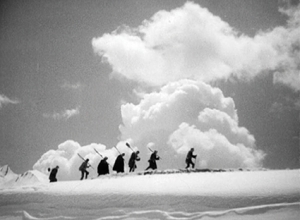Georgian Soviet Avant-Garde Filmmakers Screen in Paris
Films from Georgian Soviet avant-garde filmmakers Mikhail Kalatozov and Kote Mikaberidze will be screened at the Pompidou Center in Paris during its 2019 cinema program.
The films will be shown as part of ‘Red, art and utopia in the land of the Soviets’, organized by the RMN-GP and the Pompidou Center from March 20 to July 1. The series will showcase the works of five filmmakers linked to Soviet avant-garde art at the turn of the 1930s. It will also bring together experts who will discuss the important era of cinematography at the crossroads of aesthetic and revolutionary theories.
Born in Tbilisi in 1903, Mikhail Kalatozov won international awards for his films, including a Palme d’Or at the 1958 Cannes Film Festival for his film ‘The Cranes Are Flying’. His documentary ‘Salt for Svanetia’ screened at the Pompidou Center on April 4 as part of the series.
Kalatozov travelled to Svaneti in 1929 to document the life and customs of the Svanetian community in four villages. The black and white silent film portrayed the difficulties of a life cut off from the outside world.
Like many artists at the time, Kalatozov was forced to adapt his film style. “Accused of formalism by censorship, Kalatozov completely reworked his fiction into an ethnological and poetic documentary - Salt for Svanetia,” reads an introduction by the Pompidou Center.
On April 6, Cologne-based Georgian artist and researcher Soso Dumbadze will speak about the Soviet avant-garde filmmaker Kote Mikaberidze at the Pompidou Center. Born in Temruk, Russia, in 1896, Mikaberidze spent the majority of his life in Georgia. He was a pioneering filmmaker most famous for his 1929 silent film ‘My Grandmother.’
‘My Grandmother’ tells the story of a conscientious civil servant who, condemned to wandering after losing his job, finds protection from a ‘grandmother.’ Mikaberidze was influenced by German expressionism, surrealism, the French avant-garde movement, and constructivism.
Mikaberidze directed six films and acted in 11 from 1929 to 1941. His first film was banned by authorities in 1929, however, he was recognized for his contribution to Soviet cinema later in his career. In 1945, he was awarded the title of Artist of Honor. His work was highly influential in Soviet Georgian cinema, especially silent film.
Films were an integral part of culture in soviet times. Cinema’s ability to convey a message, and its widespread popularity, made it an important propaganda tool for the Soviet Union. In fact, Vladimir Lenin considered film to be the most important medium for educating the masses in the ways, means and successes of communism.
Therefore, cinema during soviet times was closely regulated. In 1932, after the Communist Party decided to transform the Soviet Union both economically and culturally, the party forced cinematographers to abandon avant-garde styles in favor of socialist realism. The party declared a “cultural revolution” of all areas of the arts. The film industry therefore had to adopt a film style that would portray the Soviet message in an understandable way for a broad audience.
Despite the restrictions placed on cinema at the turn of the 1930s, Soviet avant-garde cinema was diverse and of a high-quality. It offers an opportunity to revise cliches and rethink Soviet production in cinema. Guest speakers Oksana Bulgakowa, Professor of Cinematography, and Soso Dumbadze, will discuss how Soviet filmmakers made their mark on cinema after the screenings.
By Amy Jones
Photo: A still from Salt for Svaneti, Mikhail Kalatozov. Source: Centre Pompidou











